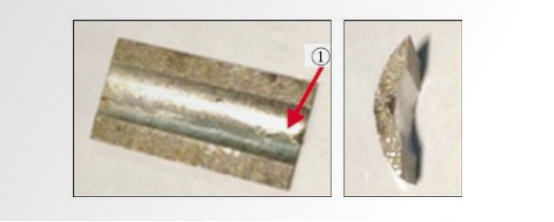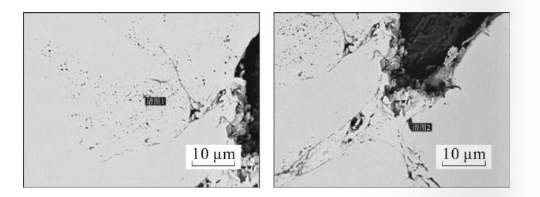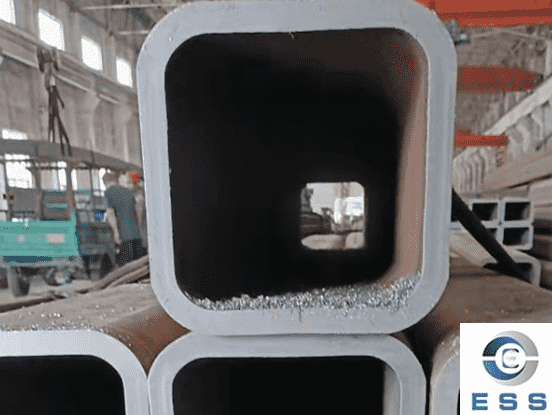Surface crack defects have a great impact on the quality of seamless stainless steel pipe during the manufacturing process and the safety of use after delivery, and are unacceptable defects; therefore, it is necessary to analyze the macroscopic characteristics of surface cracks in stainless steel seamless pipes, find out the causes of cracks, and put forward Improvements.
1 Macroscopic characteristics of seamless pipe surface cracks
Taking the 10 mmx1 mm stainless steel seamless pipe in 0Cr18Ni9 material as an example, the process route is: round steel perforation→acid cleaning→grinding→intermediate cold rolling→degreasing-→natural gas furnace heat treatment (solid solution)-→pickling -→grinding-→cold rolling of finished products-→degreasing-→bright heat treatment of finished products (solid solution)-→straightening-→cutting to length and inspection of finished products, etc. The stainless steel seamless pipe had a leak during the air tightness test of the finished product. Visual inspection found that there was a longitudinal defect on the outer surface, which was suspected to be a crack penetrating through the wall thickness direction. After dissection observation, there is indeed a crack at the corresponding position, and the cross-section can be seen through, as shown in Figure 1.

figure 1
Macro inner wall and cross-section illustration of dissected stainless steel seamless pipe
2 Physical and chemical analysis
Samples were taken from unqualified φ10mmx1mm stainless steel seamless pipes that had leaks during the airtightness test, and physical and chemical analysis was performed.
2.1 Chemical Composition Inspection
The chemical composition of the sample was analyzed according to GB/T 11170-2016 "Determination of multi-element content in stainless steel by spark discharge atomic emission spectrometry (conventional method)". After comparison, its composition meets the requirements of GB/T 14976- -2002 "Stainless steel seamless steel pipe for fluid transportation" for 0Cr18Ni9 material, and there is no obvious abnormality in the main composition of the matrix.
2.2 Analysis of mechanical properties at room temperature
(1) Tensile properties. According to GB/T 228.1- -2010 "Metallic Materials Tensile Test Part 1: Room Temperature Test Method", the room temperature tensile test was carried out, and the results are shown in Table 2. It was found that the strength and plasticity of the φ10mmxlmm stainless steel seamless pipe were better than GB/T14976 standard requirements.
(2) Flaring and flattening tests. The flaring and flattening tests are carried out in accordance with GB/T242--2007 "Metal Tube Flaring Test Method" and GB/T 246-2017 "Metal Material Tube Flattening Test Method". choose top
For a conical top core with a core angle of 60°, the expansion rate of the outer diameter is 10%, and there are no cracks or cracks on the tube wall after expansion; at the same time, there are no cracks or cracks on the inner and outer walls of the steel tube after the flattening test.
2.3 Intergranular corrosion performance test
According to GB/T 4334- -2020 "Metal and Alloy Corrosion Austenitic and Ferritic-Austenitic (Duplex) Stainless Steel Intergranular Corrosion Test Method" E method for copper-copper sulfate-16% sulfuric acid corrosion test, After bending the sample for 180°, there is no intergranular corrosion crack on the surface.
2.4 Metallographic analysis
After wire cutting and inlaying, the defective parts were cleaned ultrasonically after grinding and polishing and electrolytic corrosion with 10% oxalic acid solution, and observed under a metallographic microscope. The crack and the pipe wall form an angle of 45° and obliquely penetrate the wall thickness; there is a bifurcation in the middle of the crack, the width of the crack on the inner side of the pipe wall is wider than that on the outer side, and there are obvious folds at the bottom of the crack on the inner side; the grains near the middle of the crack have infiltrated Carbon and fine grain phenomenon, and the bifurcation is more obvious. Judging from the crack shape, the crack has undergone secondary expansion. Take a longitudinal sample near the pipe defect (position ① in Figure 1) to observe its metallographic structure, and according to GB/T 10561- -2005 "Determination of Non-metallic Inclusion Content in Steel Standard Grading Chart Microscopic Examination Method" Method A for non-metallic inclusion ratings. In the tissue, except for the B-type and D-type fine-line inclusions, which are 1.0 and 0.5 grades respectively, the rest are 0. It can be seen that the content of non-metallic inclusions in the matrix area is normal.
2.5 SEM analysis
Scanning electron microscopy analysis found that there are a large number of point and block suspected inclusions in the defect. Select some points for energy spectrum analysis of the suspected inclusions. The defect morphology under the scanning electron microscope is shown in Figure 2. The above two points have abnormally high Si and Al contents. It can be judged that there is silicon in these two places. oxide and aluminum oxide inclusions.

figure 2
Defect Morphology of Stainless Steel Seamless Tube under Scanning Electron Microscope
3 Analysis of the causes of cracks
Observing the crack morphology, the crack and the inner wall extend obliquely at an angle of 45°. Because the pipe itself has good mechanical properties and high ductility, it can be ruled out that it is caused by cold rolling. The width of the crack develops from thick to thin, and a bifurcation appears in the middle, indicating that the through crack is not formed at one time. During the cold rolling process, the steel pipe is subjected to three-dimensional compressive stress, and the wall thickness direction is mainly in the direction of two-dimensional compressive stress and two-dimensional friction resistance. Under the action of deformation and extension, the original crack expands under the action of stress. Due to the irregular bottom of the crack, bifurcation is easy to occur, and the expanded crack is thinner than the original defect. The microstructure near the crack was analyzed, and it was found that there was a fine-grained layer at the bifurcation. The reason for this phenomenon is that there are crack defects in the pipe before cold rolling, and the rolling oil enters the cracks during cold rolling, and the rolling oil in the crack gap cannot be completely removed when deoiling, while the rolling oil and degreasing agent Rich in organic matter, the rolling oil remaining in the cracks undergoes heat treatment to produce carburization. The higher the carbon content in the steel, the higher the nucleation rate, thereby forming a fine-grained layer. This shows that the defect has already appeared in the previous pass, rather than the finished product or the last cold rolling of the finished product. From the analysis of scanning electron microscope results, it can be judged that there are relatively concentrated alumina and silicon oxide inclusions in the local area of the sample. Such inclusions generally originate from smelting or casting, which lead to defects inside the round steel. During the subsequent piercing and cold rolling deformation process, they are affected by pressure processing, thereby forming cracks and penetrating through the wall thickness, causing leakage during the air tightness test. Therefore, the penetrating crack exists in the original tube blank itself, rather than expanding and cracking under the influence of pressure during the air tightness test.
4 Improvement measures
By formulating reasonable measures to control the cracks in the production process of stainless steel seamless pipes, the quality of products can be further improved.
(1) Acceptance of raw materials. For small-diameter stainless steel, the technical conditions for the purchase of special tube blanks are formulated, and detailed quantitative regulations are made on the content of inclusions and the quality of the outer surface. When re-inspecting raw materials, the level of inclusions is mainly inspected to prevent defects during processing to finished products.
(2) Strengthen waste management grinding. Strengthen visual inspection, mark the defects found, and isolate the defective steel pipes; use endoscopes and other auxiliary visual inspections to locate the defects on the inner wall of the steel pipes, and then use fixed-point grinding to polish the defects.
(3) Increase non-destructive testing. Formulate reasonable acceptance criteria, conduct ultrasonic flaw detection on steel pipes before cold rolling of finished products, mark and isolate flawed steel pipes to detect defects, and fix-point grinding to eliminate defects.
(4) Re-inspect the steel pipe after the above-mentioned fixed-point grinding with the same detection method, and if it is qualified, it will be put into production and use to prevent unqualified products from flowing into the next process.
5 Conclusion
0Cr18Ni9 material φ10mmx1mm stainless steel seamless pipe leaked at - during the air tightness test of the finished product, and it was found that there were cracks penetrating the wall thickness direction on the outer surface. According to the analysis, there are inclusions in the perforated tube blank itself, and cracks are formed during piercing, but the defects are not removed in the subsequent production process, resulting in further expansion of cracks during the cold rolling process, and finally penetrate the tube wall.













 Eastern Steel Manufacturing Co.,Ltd not only improve product production and sales services, but also provide additional value-added services. As long as you need, we can complete your specific needs together.
Eastern Steel Manufacturing Co.,Ltd not only improve product production and sales services, but also provide additional value-added services. As long as you need, we can complete your specific needs together.











